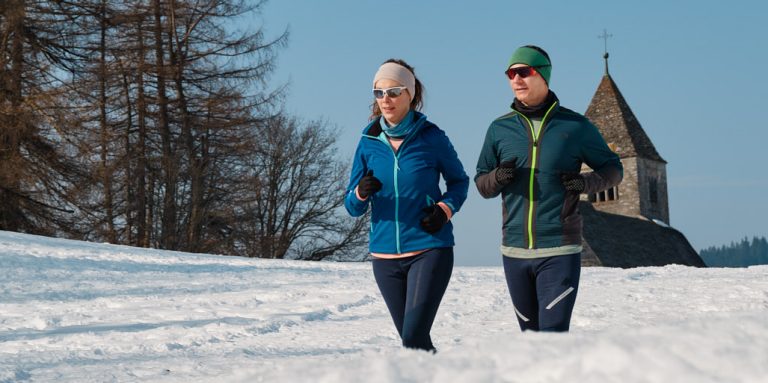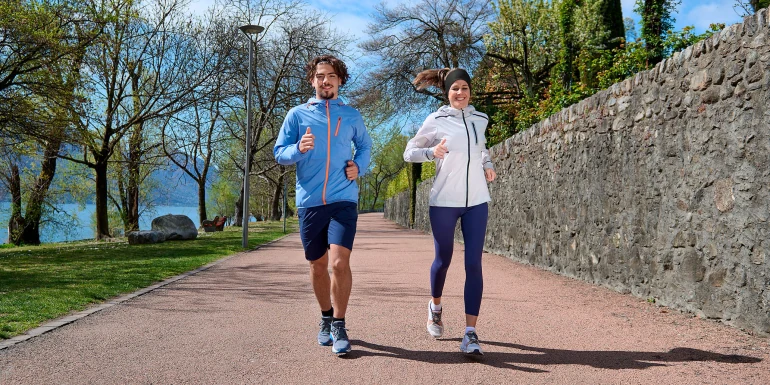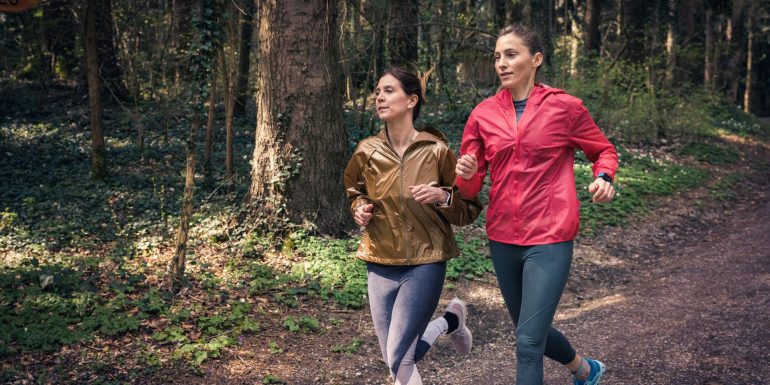
Jogging in winter: top tips
Running in the winter is particularly appealing – but it does have its downsides. Here, sport expert Joy Marxer explains how you can successfully overcome cold weather, snow and darkness.
If you take a break from running in the winter months, you’re missing out on so many things: constantly changing winter landscapes, that warm feeling after a jog, the silence that only snow can bring. Plus, if you keep jogging during winter, you won’t have to build up your stamina again in the spring.
This is because the capacity of the cardiovascular system declines quickly if it is not pushed for an extended period. Strength, coordination and flexibility also have to be built up again.
In Switzerland, there is no reason that the cold should stop you from running. On the contrary: your body actually produces more antibodies in cold temperatures. This strengthens the immune system. As long as the mercury doesn’t fall to below -10°C, there’s nothing to stop you from jogging in the winter – except your inner couch potato.
Jogging in the cold: 10 tips
1. Stay hydrated
Fluid loss while running is still very high in winter – similar to summer. We only feel less thirsty when it’s cold because our bodies don’t need to cool down as much. Make sure to drink enough before and after your jog. A warm soup after your run is a great way to get some additional heat.
2. Warming up and stretching
Extend your warm-up a little by jogging in a nice, relaxed way for 10 to 15 minutes, or do some stretching indoors beforehand to warm up your muscles. After your session, it’s better to stretch in the warm so that you don’t get cold. Or, towards the end of your run, you can go at a slower pace for 10 minutes.
3. The right clothes for winter
Dress by following the onion layering system. If you’re shivering a little at the start of your run, then that means you’re dressed correctly – you will soon warm up once you get moving. When jogging in winter, above all make sure your torso is protected. The best way to do this is with three layers of clothing:
- The first layer should be breathable and sweat-absorbing.
- The second layer provides thermal insulation.
- The third layer (a jacket) should offer protection against wind, rain and snow.
Wear long, close-fitting running trousers. These will draw moisture towards the exterior, keeping your skin dry. Gloves and a scarf offer protection from the cold, and you should think about a hat and a headband too, because the greatest heat loss when jogging is through your head. It is also advisable to wear long socks to protect your toes and the areas around your Achilles tendon and your shins.
4. Good winter shoes
Make sure to use running shoes that are specifically designed to be worn in winter. Ideally, they should also be waterproof. The raised profile ensures better grip. The rubber compound used on the soles of winter running shoes is also designed for colder temperatures and offers better shock absorption. Soles with too many gaps are unsuitable, however, because snow can build up inside these and form clumps of ice, which can affect your running. Don’t forget that shoes with reflective details will make you more visible. Trail-running shoes are best for deep snow. Spikes will give you better grip when it’s icy.
5. Increase visibility
Wear reflective clothing or bands, and maybe also a head torch, to make sure that you’re always visible at dusk, dawn and in the dark – an absolute must when jogging on pavements and roads.
6. Run during the day
Your body uses sunlight to produce vitamin D, which is essential for maintaining healthy bones, building muscles and regulating our happy hormones. If there is snow on the ground, be sure to wear sun cream if it is sunny – snow reflects sunlight. Sunglasses with orange-tinted lenses make it easier to see uneven ground.
7. Jog the right route
Forests continue to be great running terrain in winter. If running after dark, make sure you choose a well-lit route. This will help you spot any trip hazards. A head torch can help here, and is a must-have when it’s dark. Or you can use an all-weather track from time to time – these are often well-lit, so you can focus more on your technique.
Please note: routes may very well be slippery if they have just been cleared of snow. For this reason, terrain shouldn’t just be cleared of snow but should also be salted or gritted.
8. The right intensity
Adapt the intensity of your run to the temperature and your physical condition. Running regularly will cause your body to adapt to the cold. You can then increase the intensity over time. You shouldn’t try to stick to a rigid training plan, though, and you should avoid trying for any personal bests. If need be, slow down a little and run for longer instead. Did you know that jogging in the snow works your muscles in a similar way to running on sand?
9. Adapt your running technique
Adapt your running technique and your tempo to the conditions. Shorter and flatter steps will help stop you slipping. Concentrate on the propulsion and landing phases of your stride. Focus on where you place your feet for better grip. Developing a good running technique takes practice. You can also incorporate the ABCs of running into your winter training schedule – as long as there isn’t any snow or ice.
10. Tips for more motivation
Arrange to go running with friends. Or set yourself a goal, such as signing up for a race in spring. But don’t put yourself under any pressure. It’s more important to enjoy exercise and to stick with it.
If you still don’t enjoy jogging outdoors in winter, you can train on a treadmill instead. Swimming is also a good alternative. Or, why not simply focus on indoor coordination and strength training? Then you will be full of motivation to start running when spring comes around again.
Indoor training with Helsana Coach
Don’t fancy going out in the bad weather? You can train in the comfort of your own home. The free-of-charge Helsana Coach app offers various programmes and exercises to help you increase your strength and mobility – or to help you achieve your own health goals. Download now!

The sports scientist (MSc in Rehabilitation and Prevention in Sport) provided the editorial team with advice and input for this article.


Newsletter
Find out more about current health issues every month and get all the information you need about our attractive offers from all Helsana Group companies * delivered by e-mail to read whenever it suits you. Our newsletter is free of charge and you can sign up here:
We did not receive your information. Please try again later.
* The Helsana Group comprises Helsana Insurance Company Ltd, Helsana Supplementary Insurances Ltd and Helsana Accidents Ltd.
